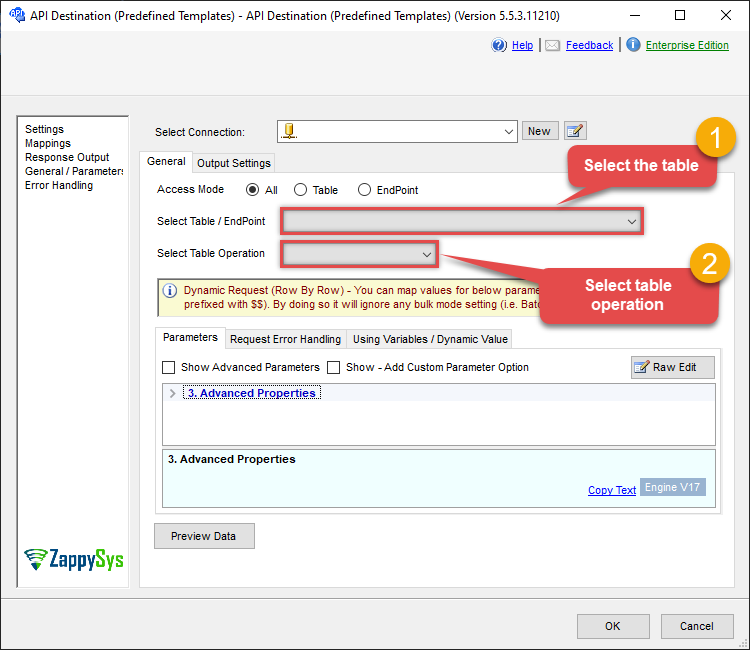Add New List Members in Bulk
Name
add_list_members_bulk
Description
Adds multiple members using Bulk API. [API reference]
Related Tables
Parameters
Output Columns
| Label | Data Type (SSIS) | Data Type (SQL) | Length | Raw | Description |
|---|---|---|---|---|---|
| Id |
DT_WSTR
|
nvarchar(100)
|
100 | False |
|
DT_WSTR
|
nvarchar(255)
|
255 | False |
||
| StatusCode |
DT_I4
|
int
|
False |
||
| OperationId |
DT_WSTR
|
nvarchar(255)
|
255 | False |
|
| ErrorTitle |
DT_WSTR
|
nvarchar(4000)
|
4000 | False |
|
| ErrorDetail |
DT_WSTR
|
nvarchar(4000)
|
4000 | False |
Input Columns
| Label | Data Type (SSIS) | Data Type (SQL) | Length | Raw | Description |
|---|---|---|---|---|---|
| EmailAddress |
DT_WSTR
|
nvarchar(200)
|
200 | False |
|
| Status |
DT_WSTR
|
nvarchar(80)
|
80 | False |
Subscriber's current status. Possible values: subscribed, unsubscribed, cleaned, pending, or transactional. |
| EmailType |
DT_WSTR
|
nvarchar(20)
|
20 | False |
Type of email this member asked to get ('html' or 'text'). |
| FirstName |
DT_WSTR
|
nvarchar(255)
|
255 | False |
|
| LastName |
DT_WSTR
|
nvarchar(255)
|
255 | False |
|
| AddressLine1 |
DT_WSTR
|
nvarchar(200)
|
200 | False |
|
| AddressLine2 |
DT_WSTR
|
nvarchar(200)
|
200 | False |
|
| City |
DT_WSTR
|
nvarchar(200)
|
200 | False |
|
| State |
DT_WSTR
|
nvarchar(100)
|
100 | False |
|
| Zip |
DT_WSTR
|
nvarchar(20)
|
20 | False |
|
| Country |
DT_WSTR
|
nvarchar(100)
|
100 | False |
|
| Phone |
DT_WSTR
|
nvarchar(50)
|
50 | False |
|
| Birthday |
DT_WSTR
|
nvarchar(50)
|
50 | False |
|
| MergeFields |
DT_WSTR
|
nvarchar(4000)
|
4000 | True |
A dictionary of merge fields where the keys are the merge tags. |
| Interests |
DT_WSTR
|
nvarchar(4000)
|
4000 | True |
The key of this object's properties is the ID of the interest in question. |
| Language |
DT_WSTR
|
nvarchar(10)
|
10 | False |
If set/detected, the subscriber's language. |
| Vip |
DT_BOOL
|
bit
|
False |
VIP status for subscriber. | |
| Latitude |
DT_WSTR
|
nvarchar(4000)
|
4000 | False |
The location latitude. |
| Longitude |
DT_WSTR
|
nvarchar(4000)
|
4000 | False |
The location longitude. |
| MarketingPermissions |
DT_WSTR
|
nvarchar(4000)
|
4000 | True |
The marketing permissions for the subscriber. |
| IpSignup |
DT_WSTR
|
nvarchar(200)
|
200 | False |
IP address the subscriber signed up from. |
| TimestampSignup |
DT_DBTIMESTAMP
|
datetime
|
False |
The date and time the subscriber signed up for the list in ISO 8601 format. | |
| IpOpt |
DT_WSTR
|
nvarchar(200)
|
200 | False |
The IP address the subscriber used to confirm their opt-in status. |
| TimestampOpt |
DT_DBTIMESTAMP
|
datetime
|
False |
The date and time the subscriber confirmed their opt-in status in ISO 8601 format. | |
| Tags |
DT_WSTR
|
nvarchar(4000)
|
4000 | True |
The tags that are associated with a member. |
Examples
SSIS
Use Mailchimp Connector in API Source component to read data or in API Destination component to read/write data:
Insert into ListMembersBulk table using API Destination
This Endpoint belongs to ListMembersBulk table, therefore you cannot work with it directly. Use this table and table-operation pair instead:

ODBC application
Use these SQL queries in your ODBC application data source:
Bulk Add Subscibers (members) to the List from Source like MSSQL, ODBC
INSERT INTO ListMembersBulk
SOURCE('ODBC', 'DSN=MyOdbcDsn
,'select col1 as EmailAddress,col2 as FirstName, col3 as Status') --//column name alias must match with InputColumns of ListMembers
WITH(ListId='a4d24015f8')
add_list_members_bulk endpoint belongs to
ListMembersBulk
table(s), and can therefore be used via those table(s).
SQL Server
Use these SQL queries in SQL Server after you create a data source in Data Gateway:
Bulk Add Subscibers (members) to the List from Source like MSSQL, ODBC
DECLARE @MyQuery NVARCHAR(MAX) = 'INSERT INTO ListMembersBulk
SOURCE(''ODBC'', ''DSN=MyOdbcDsn
,''select col1 as EmailAddress,col2 as FirstName, col3 as Status'') --//column name alias must match with InputColumns of ListMembers
WITH(ListId=''a4d24015f8'')';
EXEC (@MyQuery) AT [LS_TO_MAILCHIMP_IN_GATEWAY];
add_list_members_bulk endpoint belongs to
ListMembersBulk
table(s), and can therefore be used via those table(s).
